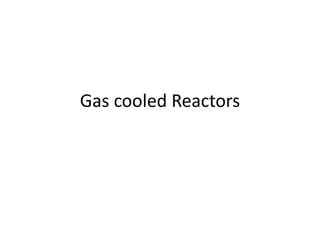
Gas cooled reactors
- 2. For more help contact me Muhammad Umair Bukhari Engr.umair.bukhari@gmail.com http://onlinemetallurgy.com
- 3. History of Gas Cooling • CP1 was first reactor without coolant in Chicago and structure was made up of wood and bricks
- 4. First Gas Cooled Reactor • For the first time coolant was used in November 1943 at Oak Ridge • And first coolant was air • X10 was first air cooled reactor • Wind scale in UK and G1 also used air as coolant
- 5. X10 Air Cooled Reactor
- 6. Purpose of Coolant • The real task of a coolant is not to cool the fuel but to transport heat from the reactor core to the boilers to produce steam for electricity generation or to generate process heat.
- 7. Why Gas as Coolant? Gases exhibit interesting qualities such as – The density of a gas is variable, its operating temperature can be chosen independently of the operating pressure. Thus a high gas temperature can be used, limited only by the core and circuit materials, to give good steam conditions from the boiler and thus good conversion of heat to electrical energy through the resulting high turbine efficiency
- 8. Why Gas as Coolant? • Gases also has certain intrinsic safety advantages e.g. – They don’t undergo any phase change as a result of rising temperature or falling pressure, resulting • Cooling continuity • Continuous flow • Ease of temperature calculation
- 9. Why Gas as Coolant? • On-load refueling is more easily achieved with a gas • There is no risk of a fuel-coolant interaction of the kind that in certain circumstances could result from the dispersion of melted fuel in a liquid coolant.
- 10. Why Gas as Coolant? • A gas carries a relatively low burden of activated corrosion products • And low neutron absorption cross section
- 11. Limitations Some limitation associated with gases are • low specific heat of gases, and requires large volume flows to transport the heat results in – large circulator sizes and powers
- 12. Some gases of choice
- 13. Gas cooled reactor • Natural uranium, graphite-moderated reactors were developed in the United States during World War II for the conversion of 238U to 239pu for military purposes. • Most “first generation” gas-cooled power plants were designed and built in the UK– the Magnox series – and in France – the NUGG.
- 14. Features of First Generation Reactor • Natural uranium (in metallic) fueled reactor • Fuel was in form of bars cladded in Mg-alloy • Graphite moderator • CO2 gas as coolant • Their ability to unload the fuel without having to shut down the reactor made it possible to produce almost pure 239Pu for military applications by short irradiation.
- 15. Cont…. • Ealier Magnox has efficiency 22% and after development it reached to peak of 33.6% • Gas pressure of a typical reactor was 6.9 bar and temperature was limited to 340oC • Boiler was integrated with core • NUGG used the pressure of CO2 29 bar
- 16. 300 MWe Magnox reactor Oldbury A1 (Marshall W 1981)
- 17. CO2 Characteristics • CO2 has following characteristics – Easily available, cheap – Good heat transfer rate – Good chemical compatibility with core materials( e.g graphite moderator, cladding material & fuel) – Compatible neutronic properties with graphite moderator
- 18. AGR ( Advance Gas Cooled Reactor) • Magnox were predecessor of AGR • AGR differs from latest Magnox in fuel elements • They can operate on low enriched uranium oxide fuel in form of small dia. Pins • Cladding material was stainless steel
- 19. AGR features • UO2 and CO2 compatibility made the high temp 650oC possible • And efficiency reached at 42% • Methane was used in coolant to avoid corrosion
- 21. Fuel element features of AGR
- 22. High temperature Reactor • In 1970 and 1980 in Germany and USA • They differ from AGR with use of He as coolant and different type of fuel • Fuel element was 1mm diameter particles or 6cm dia. spheroid • Used dual coating of pyrocarbon and SiC • Operating temperature achieved was 750- 850oC and pushed at the limit of 1050oC
- 24. Gen IV GFR (Gas Cooled Fast reactor) • Mostly paper work or lab scale • Modified form of HTR’s • Some modification are made in flow cycle of helium • They are also known as high efficiency reactors
- 25. • Gen IV introduced the “twofold” concept – combining high thermodynamic efficiency through high temperatures, and high neutronic efficiency (with significant economization of resources in the case of the uranium-plutonium cycle) through fast spectrum conditions.
- 26. Flow sheet of Gen IV GFR
- 27. Gen IV Concept • Gen IV concept mainly focus on – High efficiency – Safety and environment friendly
